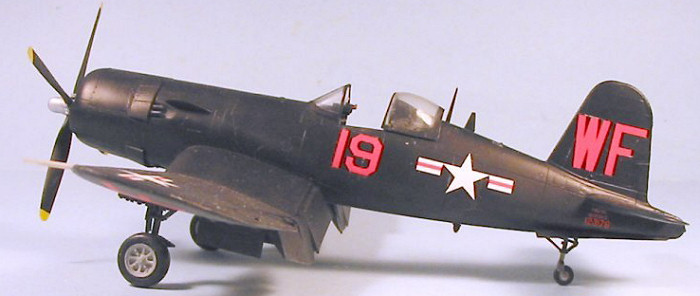
| KIT: | Hasegawa 1/48 F4U-5N |
| KIT #: | 09075 |
| PRICE: | $24.95 MSRP |
| DECALS: | See Review |
| REVIEWER: | Tom Cleaver |
| NOTES: |

| HISTORY |
The F4U-5 was the ultimate Navy development of the Corsair series as a fleet defense fighter. The first prototype took to the skies December 21, 1945. It differed from previous Corsairs by having an even longer nose, a raised cockpit, and all-metal wings. Powered by a Pratt and Whitney R-2800-32W providing 2,450 h.p., the F4U-5 was the fastest piston-engine aircraft to ever operate from a USN aircraft carrier: 462 mph at 31,400 ft. Armament was upgraded from .50 caliber machine guns to four 20mm cannon as standard, with provision for two 1,000 lb. bombs and 8 5-inch HVARs. Of a total 568 F4U-5Ns produced between 1946-49, 223 were F4U-5, 214 were F4U-5N, 101 were winterized F4U-5NL, and 30 were F4U-5P photo recon aircraft.
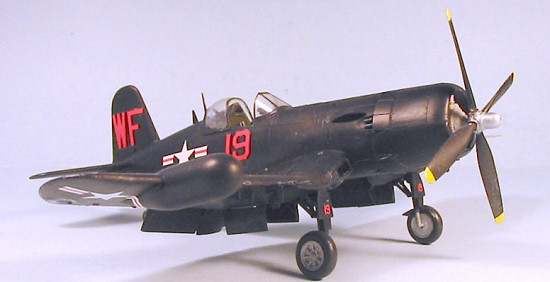 The F4U-5N radar-equipped
night fighter first went to war with VMF(N)-513, "The Flying Nightmares," in
1950. When the war broke out in June 1950, VMF(N)-513 was the only Marine night
fighting squadron in the far East, based at Itazuke in Japan. The squadron
remained in Japan but gave close support to UN troops in Korea throughout the
summer, specializing in night attack against North Korean transport, flying 343
sorties in support of the Pusan fighting. Led by Major Hunter Reinburg, a
Guadalcanal veteran, VMF(N)-513 arrived at Kimpo airfield shortly after it fell
to Marines in September. The squadron provided support to the First Marine
Division during the drive into North Korea in October and November, and first
provided night close air support for the First Marine Division during the
breakout from the Chosin Reservoir in November-December 1950.
The F4U-5N radar-equipped
night fighter first went to war with VMF(N)-513, "The Flying Nightmares," in
1950. When the war broke out in June 1950, VMF(N)-513 was the only Marine night
fighting squadron in the far East, based at Itazuke in Japan. The squadron
remained in Japan but gave close support to UN troops in Korea throughout the
summer, specializing in night attack against North Korean transport, flying 343
sorties in support of the Pusan fighting. Led by Major Hunter Reinburg, a
Guadalcanal veteran, VMF(N)-513 arrived at Kimpo airfield shortly after it fell
to Marines in September. The squadron provided support to the First Marine
Division during the drive into North Korea in October and November, and first
provided night close air support for the First Marine Division during the
breakout from the Chosin Reservoir in November-December 1950.
Following the ejection of U.N. forces from North Korea by the Chinese, the squadron - along with the F7F-3N-equipped VMF(N)-542, retreated back to Itazuke. When the front stabilized, the night fighters returned to Kimpo and the Corsairs operated in the night intruder role, attacking North Korean and Chinese truck convoys and supply trains beginning in January 1951. VMF(N)-542 was returned to the United States at the end of January to re-equip with the F3D-1 Skynight. The Tigercats were taken over by VMF(N)-513 and operated alongside the Corsairs.
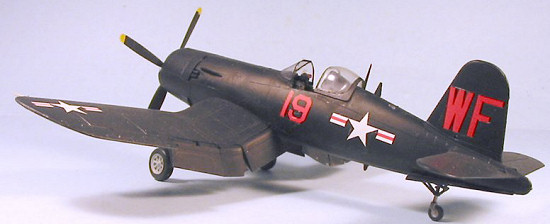 In the Spring of 1951,
the aircraft lost their Gloss Sea Blue finish with white markings, being
repainted in Japan an overall flat black with markings in red and smaller
national insignia to better suit them for the night interdiction role.
In the Spring of 1951,
the aircraft lost their Gloss Sea Blue finish with white markings, being
repainted in Japan an overall flat black with markings in red and smaller
national insignia to better suit them for the night interdiction role.
Captain Don Fenton brought down a North Korean “Bed-Check Charlie” over Seoul in July1951, flying an F4U-5N. A year later, in July 1952, 1st Lt. John Andre shot down a Yak-9, for his 5th kill including 4 from World War II, making him one of the few pilots to become an ace over the course of two wars and one of the few night fighter aces, since his four kills in World War II had been gained at night with VMF(N)-514 in the Philippines.
Later that month, VMF(N)-513 added 12 F3D-2 Skynights - which they would operate over North Korea in the escort role for night-bombing B-29s - to the 9 Tigercats and 6 Corsairs they continued to operate in night close air support along the Main Line of Resistance until May 1953 when the unit completely re-equipped with jets.
| THE KIT |
The model comes on nine sprues of light grey plastic and one clear. The parts are crisp and flash‑free. The best description is "the Tamiya Corsair without folding wings."
Though Hasegawa has established a new level of cockpit detail with the release of the Tenzan, Hayate and Shiden‑Kai models, the cockpit detail of this F4U‑5N reverts to the quality level of the F‑86 Sabre and P‑47 Thunderbolts, i.e., adequate but not great. There have been several resin cockpits released for the kit since it was first released in 2000.
The kit is also available as a release from Revell of Germany and in ProModeler boxes.
| CONSTRUCTION |
Like all the recent Hasegawa releases, the kit is well‑engineered and assembles with a minimum of hassle. There are none of the fit problems that used to plague Hasegawa kits, like the wing‑to‑fuselage join of the P‑47 or the cockpit splice of the Typhoon.
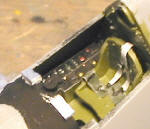 The cockpit is simple, but then the cockpit of the real thing was much
simplified as compared to the preceding Corsairs. The cockpit of most Navy
night fighters were painted black when they got to the unit. I painted the
cockpit black, adding color by painting the switches on the side consoles, and
making seat pads from gaffer's tape, which were painted yellow. I
also used some photo‑etch levers to flesh out the throttle quadrant, and
finished off with a Pro‑Modeler seatbelt decal, which I applied to some lead
foil from a wine bottle, then cut free. The foil allows the seat belt to be
posed more realistically that would otherwise be the case with a decal. The
gunsight provided in the kit is the N‑5 used by the F4U‑5, rather than the
gyroscopic N‑20 sight used in the F4U‑5N. I replaced the kit part with a K‑14
gunsight from an old Monogram P‑51D kit, which looks very close to the N‑20 ‑ at
least in 1/48 scale. I also added the control boxes for the armament which were
positioned on the coaming, to either side of the gunsight.
The cockpit is simple, but then the cockpit of the real thing was much
simplified as compared to the preceding Corsairs. The cockpit of most Navy
night fighters were painted black when they got to the unit. I painted the
cockpit black, adding color by painting the switches on the side consoles, and
making seat pads from gaffer's tape, which were painted yellow. I
also used some photo‑etch levers to flesh out the throttle quadrant, and
finished off with a Pro‑Modeler seatbelt decal, which I applied to some lead
foil from a wine bottle, then cut free. The foil allows the seat belt to be
posed more realistically that would otherwise be the case with a decal. The
gunsight provided in the kit is the N‑5 used by the F4U‑5, rather than the
gyroscopic N‑20 sight used in the F4U‑5N. I replaced the kit part with a K‑14
gunsight from an old Monogram P‑51D kit, which looks very close to the N‑20 ‑ at
least in 1/48 scale. I also added the control boxes for the armament which were
positioned on the coaming, to either side of the gunsight.
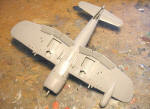 Other than the additions to the cockpit, I built the model out of the box
according to the instructions and encountered no difficulties other than having
to sand off the “ledge” on the forward fuselage, cover it with Mr. Surfacer 500,
sand it smooth then re-scribe the engraved detail in the area.
Other than the additions to the cockpit, I built the model out of the box
according to the instructions and encountered no difficulties other than having
to sand off the “ledge” on the forward fuselage, cover it with Mr. Surfacer 500,
sand it smooth then re-scribe the engraved detail in the area.
Once the wing was assembled, I noticed some mold sinking on the upper surfaces over the molded‑in wheel wells. This isn't a big deal, and it seemed to me that cleaning it up would result in more loss of surface detail than was warranted by the problem. One can always explain it away as stress on the aluminum.
| COLORS & MARKINGS |
Painting:
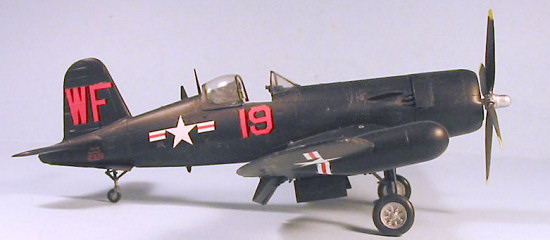 I painted the wheel
wells, landing gear and inside of the gear doors Glossy Sea Blue, as they
originally were. The rest of the model was painted with Tamiya Semi-gloss
Black. After it had dried, it was given a coat of Future for the decals.
I painted the wheel
wells, landing gear and inside of the gear doors Glossy Sea Blue, as they
originally were. The rest of the model was painted with Tamiya Semi-gloss
Black. After it had dried, it was given a coat of Future for the decals.
Decals:
The Hasegawa kit decals for the Marine night fighter version have the markings in a shade of red that is too dark. The right color was a bright “orangy-red.” I used the decals from the now out of production Victory Decals sheet, which are the correct color (Though you cannot see this fact in the photos, since my camera doesn’t like to reproduce red-orange). Since the airplanes were overpainted rather than re-painted, there were no stencils to apply.
| FINAL CONSTRUCTION |
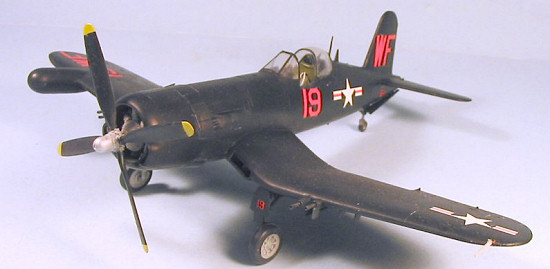 While the Corsairs ended
up quite dinged, when they were first repainted, color photos show they were
very clean, and that they stayed this way for a considerable period. Thus, I
did not weather the model, leaving it in the “fresh” condition.
While the Corsairs ended
up quite dinged, when they were first repainted, color photos show they were
very clean, and that they stayed this way for a considerable period. Thus, I
did not weather the model, leaving it in the “fresh” condition.
| CONCLUSIONS |
I really like the Hasegawa late Corsairs. Out of the box they look good, and with a resin cockpit they look even better.
April 2006
Review Kit courtesy of my wallet.
If you would like your product reviewed fairly and quickly by a site that has nearly 300,000 visitors a month, please contact me or see other details in the Note to Contributors.